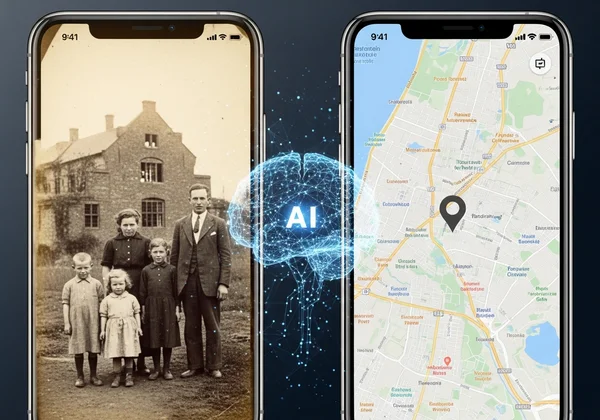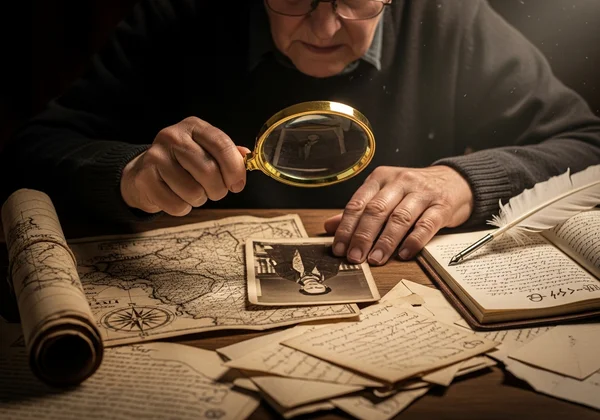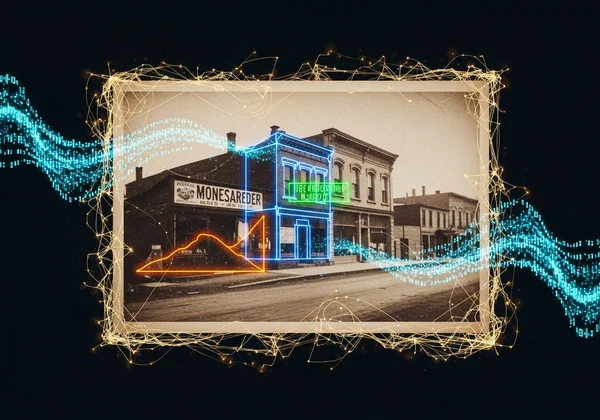Find Old Photo Location: Genealogy & AI Guide
Have you ever held a faded photograph of a relative, wondering about the world that existed just beyond the frame? These treasured images are windows into our family's past, but they often come with a frustrating mystery: where on Earth were they taken? For anyone delving into their family history, finding an old photo location is a critical piece of the puzzle. But how to find where a picture was taken online for free when it’s a century-old print from a dusty attic box? The good news is that modern technology now offers a powerful solution.
This guide is designed for the family historian, the curious descendant, and the digital archivist. We'll explore the traditional detective work of genealogy photo analysis and then reveal how cutting-edge artificial intelligence can bridge the gaps that time has created. Prepare to unlock the stories hidden in your ancestral photos and connect with your heritage in a way you never thought possible. Your journey into the past starts with a single click; discover photo locations today.

The Mystery of Old Photos: Why Locations Go Missing
Before we dive into solutions, it's essential to understand why identifying the location of old photos is so challenging. Unlike modern digital images that often embed GPS coordinates directly into the file, historical photographs are analog artifacts. When they are digitized or scanned, they carry none of this convenient background information, leaving us with only the visual data within the frame.
The Absence of EXIF Data in Scanned Images
Modern cameras, including smartphones, automatically record Exchangeable Image File Format (EXIF) data. This metadata acts as a digital fingerprint, storing details like the camera model, shutter speed, ISO, and, most importantly, the precise GPS coordinates of where the photo was taken. When you scan an old paper photograph, you are essentially creating a new digital image of that print. This new file's EXIF data will reflect the date and location of the scan itself, not the original scene, rendering it useless for historical investigation. This absence of metadata is the primary technical hurdle in historical photo identification.
Faded Memories & Lost Contextual Clues
The human element is just as significant. The generations that could have provided context—"That was taken at Aunt Mary's farm in the summer of '48"—are often no longer with us. Family stories become fragmented, and written labels on the back of photos can be cryptic, faded, or non-existent. Without this direct knowledge, we are left to piece together the narrative from silent images, a task that has traditionally been difficult and time-consuming for even the most dedicated genealogists.
Becoming a Photo Detective: Manual Techniques for Historical Identification
Before the advent of AI, genealogy photo analysis relied on meticulous observation and research. These foundational skills are still incredibly valuable and can be used in tandem with technology to confirm results and uncover deeper stories. Becoming a photo detective means learning to see what's hidden in plain sight.

Analyzing Architecture, Landmarks, and Landscapes
Every building tells a story. Look closely at architectural styles. Are the houses built of brick, wood, or stone? Do they have distinctive features like Victorian gingerbread trim or a flat-roofed modern design? Unique churches, town halls, or bridges can be powerful clues. Even natural landscapes, such as specific mountain ranges, coastlines, or types of vegetation, can help you narrow down a region. Cross-referencing these visual cues with old maps and local archives can often lead to a breakthrough.
Clothing, Vehicles, and Objects as Time Markers
The contents of a photo are a time capsule. The style of clothing—from the cut of a suit to the length of a dress—can help you date a photo with surprising accuracy. Similarly, the models of cars, farm equipment, or even storefront signs can place an image within a specific decade. These objects provide critical context, helping you focus your search on historical records from the correct era. Every detail matters when you are trying to find a location from a picture.
Tapping into Local History Resources & Family Lore
Never underestimate the power of community knowledge. Contacting local historical societies, libraries, or even online community groups for the suspected region can be incredibly fruitful. Someone might recognize a specific building or family name. Share the photo (if you're comfortable) and the story you know. Combining these external resources with fragmented family stories can help you piece together the puzzle and pinpoint your ancestral hometowns.
Your Partner in Finding Old Photo Locations
While manual detective work is rewarding, it can be slow and often hits a dead end. This is where artificial intelligence transforms the search. Our advanced tool was designed to tackle the core problem of photos without GPS data. It serves as your digital partner, performing a level of historical photo identification that was previously impossible.
How AI Analyzes Scanned Images Without Metadata
So, how does it work? Instead of looking for hidden data, our AI looks at the pixels themselves—just like a human detective, but with the power of a massive global database. Here’s a glimpse into the AI's "thinking" process:

- Landmark Recognition: The AI is trained on millions of images of natural and man-made landmarks, from famous monuments to obscure local churches. It can identify a specific bridge or building even if it's partially obscured or viewed from an unusual angle.
- Architectural Style Analysis: The system can recognize distinct architectural patterns—like Gothic Revival or Art Deco—and match them to regions where that style is prevalent.
- Text Recognition (OCR): If there are any signs, posters, or license plates in the image, Optical Character Recognition (OCR) technology can read the text, providing powerful keywords for a geographic search.
- Geographic Feature Matching: The AI analyzes landscapes, comparing coastlines, mountain silhouettes, and plant life to geographic data to propose likely regions.
By fusing these different analytical paths, the platform can generate a highly probable location with a confidence score, giving you a powerful starting point for your research. It’s the ultimate tool for geolocating historical images.
Step-by-Step: Uploading and Interpreting Your Results
We’ve made the process incredibly simple so you can focus on discovery, not on learning complex software.

- Scan Your Photo: Create a clear, high-resolution digital copy of your old photograph. The better the quality, the more detail the AI has to work with.
- Upload to the platform: Visit our homepage and simply drag and drop your scanned image into the analysis window. There's no software to install and no lengthy sign-up process.
- Watch the AI Work: Our system will show you its progress as it analyzes the image, extracts features, and matches them against its database.
- Review Your Results: In seconds, you'll see your photo alongside an interactive map pinpointing the likely location. You'll also see the location name, coordinates, and a confidence score to help you judge the result's accuracy.
It's that easy. You can go from a mysterious print to a precise spot on the map in under a minute. Try our free AI tool and see for yourself.
Case Studies: Genealogists' Success Stories with AI
The true power of this technology is best seen through the stories it helps uncover. We've heard from countless users who have broken through genealogical brick walls and reconnected with their family's journey using our tool. This is where AI photo analysis becomes truly personal.
From Faded Sepia to Google Maps: A Family Discovery
One user, Sarah, had a single sepia photo of her great-grandparents standing in front of a small, distinctive stone church. The family knew they had emigrated from somewhere in Ireland, but the exact village was lost to time. She had tried posting it in genealogy forums with no luck. After uploading the photo to our system, the tool identified the unique stonework and bell tower as belonging to St. Brendan's Church in County Galway. Within minutes, she was exploring her ancestral village on a map, a place her family hadn't been able to name for over 80 years.
Tips for Maximizing AI Success with Your Historical Photos
To get the best results when you find location of old photos, keep these tips in mind:
- Use the Highest Resolution Scan: A detailed scan allows the AI to pick up on subtle clues like text on a distant sign or unique architectural carvings.
- Crop Strategically: If a photo contains multiple elements, try cropping to focus on the most unique feature, like a specific building or monument, and running it through the analyzer.
- Combine with Your Knowledge: Use the AI's suggestion as your primary lead. Then, use the manual detective techniques mentioned earlier to confirm the location through local archives and historical records.
- Don't Give Up on Blurry Images: Our AI can sometimes identify locations from surprisingly low-quality images, so it’s always worth a try. Why not upload your old photo and test it now?
Unearthing Your Family's Past, One Photo at a Time
Every old photograph is a dormant story waiting to be told. For decades, the secrets of their locations were locked away by faded memories and the limitations of analog media. Today, the combination of human curiosity and artificial intelligence has given us the key. By blending traditional genealogical research with the powerful visual analysis provided by our AI, you can rediscover the landscapes of your heritage and walk the streets your ancestors once knew.
The journey to find an old photo location is more than just a technical exercise; it's a profound way to connect with your roots. We invite you to begin that journey today. Gather your mysterious family photos, and let technology help you reveal their long-lost secrets. Visit our site to upload your first image for free and watch as the past comes into focus.
Frequently Asked Questions About Identifying Old Photo Locations
Can our AI-powered tool find a location from severely damaged or low-resolution old photos?
While higher resolution and better condition always yield more accurate results, our AI is designed to work with imperfect images. It can often identify key features even in photos with tears, fading, or blurriness. The confidence score provided with the results will help you understand how certain the AI is. The best way to know is to analyze your image and see what it discovers.
What should I do if my old photo has no identifiable landmarks or unique visual cues?
This is the most challenging scenario for any identification method. If a photo is taken indoors with no windows or in a generic natural setting like a field, location finding is difficult. However, our AI can sometimes pick up on subtle clues like regional plant species or soil color. We recommend combining the AI analysis with traditional research into your family's known migration paths.
How accurate is the AI in geolocating historical images compared to modern photos?
The accuracy for historical photos depends heavily on the visible content. If a prominent landmark that still exists today is visible, the accuracy can be extremely high. For scenes that have changed significantly over time, the AI relies on a wider range of clues, which might result in a broader regional suggestion. Modern photos with EXIF data will always be more precise, but our AI provides the best possible solution for images that have none.
Is using this tool for old photos free, and is my privacy protected?
Yes, you can get started and analyze photos for free. We are committed to user privacy. As our privacy policy states, we handle all uploaded images securely. The photos are used solely for the analysis you request and are not used for any other purpose or shared publicly. Your family's history is safe with us.